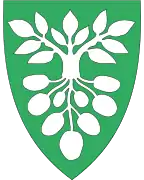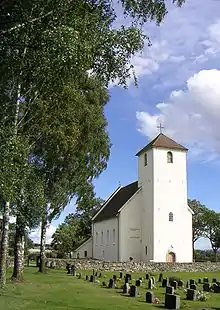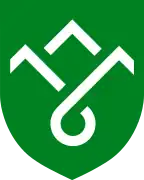Østre Toten Municipality
Østre Toten kommune | |
|---|---|
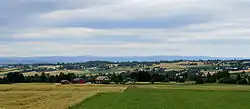 View of Østre Toten | |
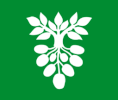 Flag | |
 Innlandet within Norway | |
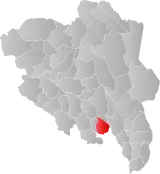 Østre Toten within Innlandet | |
| Coordinates: 60°36′48″N 10°54′58″E / 60.61333°N 10.91611°E | |
| Country | Norway |
| County | Innlandet |
| District | Toten |
| Established | 1 Jan 1838 |
| • Created as | Formannskapsdistrikt |
| Administrative centre | Lena |
| Government | |
| • Mayor (2019) | Bror Helgestad (Sp) |
| Area | |
| • Total | 562.56 km2 (217.21 sq mi) |
| • Land | 485.48 km2 (187.44 sq mi) |
| • Water | 77.09 km2 (29.76 sq mi) 13.7% |
| • Rank | #193 in Norway |
| Population (2023) | |
| • Total | 14,896 |
| • Rank | #83 in Norway |
| • Density | 30.7/km2 (80/sq mi) |
| • Change (10 years) | |
| Demonym | Østretotning[1] |
| Official language | |
| • Norwegian form | Bokmål |
| Time zone | UTC+01:00 (CET) |
| • Summer (DST) | UTC+02:00 (CEST) |
| ISO 3166 code | NO-3442[3] |
| Website | Official website |
Østre Toten is a municipality in Innlandet county, Norway. It is located in the traditional district of Toten. The administrative centre of the municipality is the village of Lena. Other villages in the municipality include Kapp, Kolbu, Kraby, Lensbygda, Nordlia, Skreia, and Sletta.
The 563-square-kilometre (217 sq mi) municipality is the 193rd largest by area out of the 356 municipalities in Norway. Østre Toten is the 83rd most populous municipality in Norway with a population of 14,896. The municipality's population density is 30.7 inhabitants per square kilometre (80/sq mi) and its population has increased by 0.9% over the previous 10-year period.[4][5]
General information

The parish of Østre Toten was established as a municipality on 1 January 1838 (see formannskapsdistrikt law). On 1 January 1875, there was a border change between Vestre Toten Municipality and Østre Toten Municipality. On 1 January 1896, a small area of Østre Toten (population: 49) was transferred to the neighboring Vardal Municipality. During the 1960s, there were many municipal mergers across Norway due to the work of the Schei Committee. On 1 January 1964, the neighboring Kolbu Municipality (population: 2,909) was merged with Østre Toten to form a new, larger Østre Toten Municipality.[6]
Etymology
The municipality is named Østre Toten after the district of Toten (Old Norse: Þótn). The name is identical with the word Þótn which has an uncertain meaning, but it might be from the word þóttr which means "the pleasant district" or "something one likes". The parish of Toten was divided into two parts (eastern and western) in 1825 and the first word, østre was added to signify that this was the "eastern" part, thus the name was Østre Toten which means "(the) eastern (part of) Toten".[7][8]
Coat of arms
The coat of arms was granted on 27 March 1987. The official blazon is "Vert, a potato plant argent" (Norwegian: I grønt en sølv potetplante). This means the arms have a green field (background) and the charge is a potato plant. The potato plant has a tincture of argent which means it is commonly colored white, but if it is made out of metal, then silver is used. The green color in the field symbolizes the importance of agriculture in the municipality and the potato was chosen since that is a particularly important crop that is grown in the municipality. The arms were designed by Arne Løvstand. The municipal flag has the same design as the coat of arms.[9][10][11]
Churches
The Church of Norway has five parishes (sokn) within the municipality of Østre Toten. It is part of the Toten prosti (deanery) in the Diocese of Hamar.
| Parish (sokn) | Church name | Location of the church | Year built |
|---|---|---|---|
| Balke | Balke Church | Skreia | 1170 |
| Totenviken Church | Totenvika | 1896 | |
| Hoff | Hoff Church | Kraby | c. 1175 |
| Kapp | Kapp Church | Kapp | 1939 |
| Kolbu | Kolbu Church | Kolbu | 1730 |
| Nordlien | Nordlien Church | Nordlia | 1901 |
Geography
Østre Toten is bordered to the west by Vestre Toten, to the north by Gjøvik, as well as by Hurdal and Eidsvoll in neighboring Akershus county. The highest peak is Torsæterkampen with a height of 841 metres (2,759 ft).
Settlement in Østre Toten is predominantly dispersed. In January 2015, 42.6% of the population lived in areas defined as urban settlements by Statistics Norway,[12] compared to 81% for Norway as a whole.[13] The urban settlements in Østre Toten are Kapp, Kolbu, Lena, Lensbygda, Nordlia, Skreia and Sletta.
History
| Ancestry | Number |
|---|---|
| 375 | |
| 194 | |
| 76 | |
| 62 | |
| 47 | |
| 46 | |
| 46 | |
| 44 | |
| 42 | |
| 36 |
According to the sagas, Halfdan Hvitbeinn (Whiteleg) was the first Yngling in Norway. He conquered Romerike, part of Hedmark, part of Vestfold, and Toten. He was killed in Toten around the year 740.[15]
In 1021, according to saga, King Olaf (reigned 1015–1028) converted Toten to Christianity. Also, King Håkon IV (reigned 1217–1263) came to Toten around the year 1226 to settle local unrest.[15]
Christian II (1481–1559) was a Danish monarch and King of Denmark and Norway from 1513–1523 and also the King of Sweden from 1520–1521, under the Kalmar Union. Prior to becoming king, Duke Christian was sent to Norway in 1506 by John II (also called Hans), King of Norway (1483–1513) to take charge of the kingdom. In 1507, he became aware of a revolt in Hedmark. In early 1508, he took a force there, routing the rebellion. He then rowed across lake Mjøsa to Toten, capturing residents, imprisoning them in the vaulted cellar of the rectory in Østre Toten and torturing them there. As a result, he determined that Bishop Karl of Hamar had been behind the rebellion. With Bishop Karl as his captive, he was able to suppress the unrest.[15]
Toten was a part of Akershus county until 1756, when it became part of Oppland county. Lauritz Weidemann, Corporal Peder Balke, and Niels Dyhren from Toten attended the 1814 constitutional convention at Eidsvold.[15]
Government
Østre Toten Municipality is responsible for primary education (through 10th grade), outpatient health services, senior citizen services, welfare and other social services, zoning, economic development, and municipal roads and utilities. The municipality is governed by a municipal council of directly elected representatives. The mayor is indirectly elected by a vote of the municipal council.[16] The municipality is under the jurisdiction of the Vestre Innlandet District Court and the Eidsivating Court of Appeal.
Municipal council
The municipal council (Kommunestyre) of Østre Toten is made up of 29 representatives that are elected to four year terms. The tables below show the current and historical composition of the council by political party.
| Party name (in Norwegian) | Number of representatives | |
|---|---|---|
| Labour Party (Arbeiderpartiet) | 11 | |
| Progress Party (Fremskrittspartiet) | 4 | |
| Conservative Party (Høyre) | 4 | |
| Pensioners' Party (Pensjonistpartiet) | 1 | |
| Red Party (Rødt) | 1 | |
| Centre Party (Senterpartiet) | 6 | |
| Socialist Left Party (Sosialistisk Venstreparti) | 1 | |
| Liberal Party (Venstre) | 1 | |
| Total number of members: | 29 | |
| Party name (in Norwegian) | Number of representatives | |
|---|---|---|
| Labour Party (Arbeiderpartiet) | 11 | |
| Progress Party (Fremskrittspartiet) | 2 | |
| Green Party (Miljøpartiet De Grønne) | 1 | |
| Conservative Party (Høyre) | 3 | |
| Red Party (Rødt) | 1 | |
| Centre Party (Senterpartiet) | 9 | |
| Socialist Left Party (Sosialistisk Venstreparti) | 1 | |
| Liberal Party (Venstre) | 1 | |
| Total number of members: | 29 | |
| Party name (in Norwegian) | Number of representatives | |
|---|---|---|
| Labour Party (Arbeiderpartiet) | 13 | |
| Progress Party (Fremskrittspartiet) | 2 | |
| Green Party (Miljøpartiet De Grønne) | 1 | |
| Conservative Party (Høyre) | 4 | |
| Christian Democratic Party (Kristelig Folkeparti) | 1 | |
| Pensioners' Party (Pensjonistpartiet) | 1 | |
| Centre Party (Senterpartiet) | 5 | |
| Liberal Party (Venstre) | 2 | |
| Total number of members: | 29 | |
| Party name (in Norwegian) | Number of representatives | |
|---|---|---|
| Labour Party (Arbeiderpartiet) | 11 | |
| Progress Party (Fremskrittspartiet) | 2 | |
| Conservative Party (Høyre) | 4 | |
| Christian Democratic Party (Kristelig Folkeparti) | 1 | |
| Pensioners' Party (Pensjonistpartiet) | 1 | |
| Centre Party (Senterpartiet) | 8 | |
| Liberal Party (Venstre) | 2 | |
| Total number of members: | 29 | |
| Party name (in Norwegian) | Number of representatives | |
|---|---|---|
| Labour Party (Arbeiderpartiet) | 12 | |
| Progress Party (Fremskrittspartiet) | 5 | |
| Conservative Party (Høyre) | 2 | |
| Christian Democratic Party (Kristelig Folkeparti) | 1 | |
| Pensioners' Party (Pensjonistpartiet) | 1 | |
| Centre Party (Senterpartiet) | 12 | |
| Socialist Left Party (Sosialistisk Venstreparti) | 1 | |
| Liberal Party (Venstre) | 3 | |
| Total number of members: | 37 | |
| Party name (in Norwegian) | Number of representatives | |
|---|---|---|
| Labour Party (Arbeiderpartiet) | 14 | |
| Progress Party (Fremskrittspartiet) | 4 | |
| Conservative Party (Høyre) | 2 | |
| Christian Democratic Party (Kristelig Folkeparti) | 2 | |
| Pensioners' Party (Pensjonistpartiet) | 1 | |
| Centre Party (Senterpartiet) | 10 | |
| Socialist Left Party (Sosialistisk Venstreparti) | 3 | |
| Liberal Party (Venstre) | 1 | |
| Total number of members: | 37 | |
| Party name (in Norwegian) | Number of representatives | |
|---|---|---|
| Labour Party (Arbeiderpartiet) | 16 | |
| Progress Party (Fremskrittspartiet) | 3 | |
| Conservative Party (Høyre) | 3 | |
| Christian Democratic Party (Kristelig Folkeparti) | 3 | |
| Centre Party (Senterpartiet) | 8 | |
| Socialist Left Party (Sosialistisk Venstreparti) | 2 | |
| Liberal Party (Venstre) | 2 | |
| Total number of members: | 37 | |
| Party name (in Norwegian) | Number of representatives | |
|---|---|---|
| Labour Party (Arbeiderpartiet) | 20 | |
| Progress Party (Fremskrittspartiet) | 4 | |
| Conservative Party (Høyre) | 3 | |
| Christian Democratic Party (Kristelig Folkeparti) | 3 | |
| Centre Party (Senterpartiet) | 11 | |
| Socialist Left Party (Sosialistisk Venstreparti) | 2 | |
| Liberal Party (Venstre) | 2 | |
| Total number of members: | 45 | |
| Party name (in Norwegian) | Number of representatives | |
|---|---|---|
| Labour Party (Arbeiderpartiet) | 20 | |
| Progress Party (Fremskrittspartiet) | 2 | |
| Conservative Party (Høyre) | 4 | |
| Christian Democratic Party (Kristelig Folkeparti) | 3 | |
| Centre Party (Senterpartiet) | 11 | |
| Socialist Left Party (Sosialistisk Venstreparti) | 4 | |
| Liberal Party (Venstre) | 1 | |
| Total number of members: | 45 | |
| Party name (in Norwegian) | Number of representatives | |
|---|---|---|
| Labour Party (Arbeiderpartiet) | 23 | |
| Progress Party (Fremskrittspartiet) | 4 | |
| Conservative Party (Høyre) | 5 | |
| Christian Democratic Party (Kristelig Folkeparti) | 3 | |
| Centre Party (Senterpartiet) | 7 | |
| Socialist Left Party (Sosialistisk Venstreparti) | 1 | |
| Liberal Party (Venstre) | 1 | |
| Non-party list (Upolitisk liste) | 1 | |
| Total number of members: | 45 | |
| Party name (in Norwegian) | Number of representatives | |
|---|---|---|
| Labour Party (Arbeiderpartiet) | 25 | |
| Progress Party (Fremskrittspartiet) | 2 | |
| Conservative Party (Høyre) | 6 | |
| Christian Democratic Party (Kristelig Folkeparti) | 3 | |
| Centre Party (Senterpartiet) | 6 | |
| Socialist Left Party (Sosialistisk Venstreparti) | 1 | |
| Liberal Party (Venstre) | 2 | |
| Total number of members: | 45 | |
| Party name (in Norwegian) | Number of representatives | |
|---|---|---|
| Labour Party (Arbeiderpartiet) | 23 | |
| Progress Party (Fremskrittspartiet) | 1 | |
| Conservative Party (Høyre) | 7 | |
| Christian Democratic Party (Kristelig Folkeparti) | 4 | |
| Centre Party (Senterpartiet) | 7 | |
| Socialist Left Party (Sosialistisk Venstreparti) | 1 | |
| Liberal Party (Venstre) | 2 | |
| Total number of members: | 45 | |
| Party name (in Norwegian) | Number of representatives | |
|---|---|---|
| Labour Party (Arbeiderpartiet) | 25 | |
| Conservative Party (Høyre) | 3 | |
| Christian Democratic Party (Kristelig Folkeparti) | 4 | |
| Centre Party (Senterpartiet) | 10 | |
| Socialist Left Party (Sosialistisk Venstreparti) | 2 | |
| Joint list of the Liberal Party (Venstre) and the Radical People's Party (Radikale Folkepartiet) | 1 | |
| Total number of members: | 45 | |
| Party name (in Norwegian) | Number of representatives | |
|---|---|---|
| Labour Party (Arbeiderpartiet) | 26 | |
| Conservative Party (Høyre) | 2 | |
| Christian Democratic Party (Kristelig Folkeparti) | 3 | |
| Centre Party (Senterpartiet) | 11 | |
| Joint List(s) of Non-Socialist Parties (Borgerlige Felleslister) | 3 | |
| Total number of members: | 45 | |
| Party name (in Norwegian) | Number of representatives | |
|---|---|---|
| Labour Party (Arbeiderpartiet) | 25 | |
| Conservative Party (Høyre) | 2 | |
| Christian Democratic Party (Kristelig Folkeparti) | 2 | |
| Centre Party (Senterpartiet) | 10 | |
| Socialist People's Party (Sosialistisk Folkeparti) | 2 | |
| Liberal Party (Venstre) | 4 | |
| Total number of members: | 45 | |
| Party name (in Norwegian) | Number of representatives | |
|---|---|---|
| Labour Party (Arbeiderpartiet) | 26 | |
| Conservative Party (Høyre) | 2 | |
| Communist Party (Kommunistiske Parti) | 1 | |
| Christian Democratic Party (Kristelig Folkeparti) | 2 | |
| Centre Party (Senterpartiet) | 11 | |
| Liberal Party (Venstre) | 3 | |
| Total number of members: | 45 | |
| Party name (in Norwegian) | Number of representatives | |
|---|---|---|
| Labour Party (Arbeiderpartiet) | 17 | |
| Conservative Party (Høyre) | 1 | |
| Communist Party (Kommunistiske Parti) | 1 | |
| Christian Democratic Party (Kristelig Folkeparti) | 2 | |
| Centre Party (Senterpartiet) | 6 | |
| Liberal Party (Venstre) | 1 | |
| Local List(s) (Lokale lister) | 1 | |
| Total number of members: | 29 | |
| Party name (in Norwegian) | Number of representatives | |
|---|---|---|
| Labour Party (Arbeiderpartiet) | 18 | |
| Conservative Party (Høyre) | 1 | |
| Communist Party (Kommunistiske Parti) | 2 | |
| Christian Democratic Party (Kristelig Folkeparti) | 2 | |
| Farmers' Party (Bondepartiet) | 6 | |
| Liberal Party (Venstre) | 2 | |
| Total number of members: | 29 | |
| Party name (in Norwegian) | Number of representatives | |
|---|---|---|
| Labour Party (Arbeiderpartiet) | 10 | |
| Communist Party (Kommunistiske Parti) | 2 | |
| Christian Democratic Party (Kristelig Folkeparti) | 1 | |
| Farmers' Party (Bondepartiet) | 4 | |
| Liberal Party (Venstre) | 2 | |
| Local List(s) (Lokale lister) | 1 | |
| Total number of members: | 20 | |
| Party name (in Norwegian) | Number of representatives | |
|---|---|---|
| Labour Party (Arbeiderpartiet) | 8 | |
| Communist Party (Kommunistiske Parti) | 5 | |
| Christian Democratic Party (Kristelig Folkeparti) | 1 | |
| Farmers' Party (Bondepartiet) | 4 | |
| Joint list of the Liberal Party (Venstre) and the Radical People's Party (Radikale Folkepartiet) | 2 | |
| Total number of members: | 20 | |
| Party name (in Norwegian) | Number of representatives | |
|---|---|---|
| Labour Party (Arbeiderpartiet) | 10 | |
| Communist Party (Kommunistiske Parti) | 3 | |
| Christian Democratic Party (Kristelig Folkeparti) | 1 | |
| Farmers' Party (Bondepartiet) | 4 | |
| Joint list of the Liberal Party (Venstre) and the Radical People's Party (Radikale Folkepartiet) | 2 | |
| Total number of members: | 20 | |
| Party name (in Norwegian) | Number of representatives | |
|---|---|---|
| Labour Party (Arbeiderpartiet) | 11 | |
| Radical People's Party (Radikale Folkepartiet) | 3 | |
| Farmers' Party (Bondepartiet) | 6 | |
| Total number of members: | 20 | |
| Note: Due to the German occupation of Norway during World War II, no elections were held for new municipal councils until after the war ended in 1945. | ||
Mayors
The mayors of Østre Toten:[38][39]
- 1838-1847: Peder Fauchald
- 1848-1849: Ole Larsen Hammerstad
- 1850-1856: Peder Fauchald
- 1856-1861: Ole Larsen Hammerstad
- 1862-1865: Jacob Brager
- 1866-1869: Hans Henrik Thaulow Borchgrevink
- 1870-1871: Ole Larsen Hammerstad
- 1872-1875: Carl Schjøll
- 1876-1877: Hans Laurits O. Hammerstad
- 1878-1893: Martin Adolf Andersen
- 1894-1897: Peder Madsen Wang
- 1898-1907: Adolf Rogneby
- 1908-1910: Peder Madsen Wang (LL)
- 1911-1913: Even Fodstad (LL)
- 1914-1922: Ole Weflen (AD)
- 1923-1925: Kristian Ørud (Bp)
- 1926-1928: Even Fodstad (Bp)
- 1929-1931: Ole Aass (Bp)
- 1932-1934: Ole Festad (Bp)
- 1935-1940: Einar Hermanrud (Ap)
- 1941-1943: Hans Rognerud (NS)
- 1943-1945: Nils Lundbæk (NS)
- 1945-1945: Per Gjestvang (NS)
- 1945-1967: Einar Hermanrud (Ap)
- 1968-1975: Fredrik Bredli (Ap)
- 1976-1983: Johan Nygaard (Ap)
- 1984-1991: Helge Røragen (Ap)
- 1992-1995: Hans Bjerregård (Ap)
- 1996-2003: Tor Finstad (Sp)
- 2004-2015: Hans Seierstad (Sp)
- 2015-2019: Guri Bråthen (Ap)
- 2019–present: Bror Helgestad (Sp)
Climate
Østre Toten has a subarctic climate (Dfc). It is very close to a continental climate as September averages 9.7 °C (49.5 °F) and May averages 9 °C (48 °F). Summer is the wettest time of year and winters are cold and snowy.
| Climate data for Østre Toten-Apelsvoll 1961-1990, extremes 1968-2015 | |||||||||||||
|---|---|---|---|---|---|---|---|---|---|---|---|---|---|
| Month | Jan | Feb | Mar | Apr | May | Jun | Jul | Aug | Sep | Oct | Nov | Dec | Year |
| Record high °C (°F) | 10.4 (50.7) |
11.7 (53.1) |
19.0 (66.2) |
21.6 (70.9) |
27.6 (81.7) |
32.5 (90.5) |
31.6 (88.9) |
31.6 (88.9) |
26.0 (78.8) |
20.5 (68.9) |
15.9 (60.6) |
10.4 (50.7) |
32.5 (90.5) |
| Mean daily maximum °C (°F) | −4.9 (23.2) |
−4.1 (24.6) |
1.5 (34.7) |
6.9 (44.4) |
14.3 (57.7) |
19.4 (66.9) |
20.2 (68.4) |
19.0 (66.2) |
13.7 (56.7) |
7.9 (46.2) |
1.3 (34.3) |
−2.5 (27.5) |
7.7 (45.9) |
| Mean daily minimum °C (°F) | −11.1 (12.0) |
−11.2 (11.8) |
−6.3 (20.7) |
−1.1 (30.0) |
4.7 (40.5) |
9.0 (48.2) |
10.3 (50.5) |
9.3 (48.7) |
5.8 (42.4) |
2.2 (36.0) |
−3.6 (25.5) |
−8.3 (17.1) |
0.0 (32.0) |
| Record low °C (°F) | −33.9 (−29.0) |
−31.0 (−23.8) |
−27.0 (−16.6) |
−15.4 (4.3) |
−4.8 (23.4) |
−1.0 (30.2) |
2.1 (35.8) |
0.0 (32.0) |
−4.6 (23.7) |
−13.7 (7.3) |
−18.9 (−2.0) |
−29.3 (−20.7) |
−33.9 (−29.0) |
| Average precipitation mm (inches) | 37 (1.5) |
26 (1.0) |
29 (1.1) |
32 (1.3) |
44 (1.7) |
60 (2.4) |
77 (3.0) |
72 (2.8) |
66 (2.6) |
64 (2.5) |
53 (2.1) |
40 (1.6) |
600 (23.6) |
| Average precipitation days | 8.1 | 5.7 | 6.2 | 6.0 | 7.8 | 9.2 | 10.4 | 9.7 | 9.7 | 9.8 | 9.5 | 8.5 | 100.6 |
| Source: Met Norway Eklima | |||||||||||||
Economy
Østre Toten is one of the Innlandet's most productive farming municipalities. Østre Toten is Norway's largest producers of potatoes and onions. This is reflected in the municipality's coat of arms, which displays a potato plant. The KiMs factory (which produces potato chips) is located at Skreia.
Attractions
Among the town's most notable landmarks are the old Hoff Church and the rock carvings at Glemmestad near Kapp, now displayed in the Toten Museum.
Notable people
Public Service
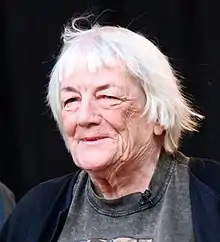
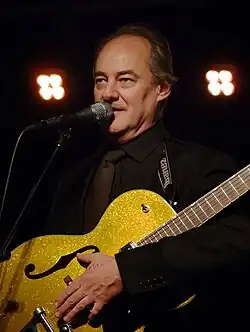

- Ole Hannibal Sommerfelt (1753 at Sukkestad – 1821), a jurist, civil servant, and topographer
- Lauritz Weidemann (1775 in Sukkestad – 1856), a Norwegian judge, civil servant, and politician
- Niels Fredriksen Dyhren (1778 in Østre Toten – 1866) & Peder Paulsen Balke (1779 in Østre Toten –1840), farmers, non-commissioner military officers and representatives at the Norwegian Constitutional Assembly
- Eduard Bøckmann (1849 in Østre Toten – 1927), a Norwegian-American ophthalmologist and physician
- E. W. Everson (1857 in Hveem - 1931), a pioneer homesteader in Dakota Territory
- Kristian Ørud (1878 at Skjefstad – 1946), a farmer and Mayor of Østre Toten in the 1920s
- twins Adolf Bredo Stabell (1908 in Kolbu – 1996), a Norwegian diplomat & Peter Platou Stabell (1908 in Kolbu – 1992), a Norwegian barrister.
- Atle Ørbeck Sørheim (born 1933 in Østre Toten), a Norwegian veterinarian and civil servant[40]
The Arts
- Peder Balke (1804–1887), a painter of romantic and dramatic landscapes, lived in Toten
- Marie Wexelsen (1832 in Østre Toten – 1911), an educator, poet, children's writer, and novelist
- Leif Solberg (1914 in Lena – 2016), a Norwegian classical composer and organist
- Margit Sandemo (1924 in Lena – 2018), a Norwegian-Swedish historical fantasy author
- Svein Erik Brodal (born 1939 in Østre Toten), an actor, theatre director, novelist and politician[41]
- Einar Steen-Nøkleberg (1944 in Østre Toten), a classical pianist and musical pedagogue
- Inger Lise Rypdal (born 1949 in Lena), a Norwegian singer and actress[42]
- Maj Britt Andersen (born 1956 in Østre Toten), a Norwegian singer
- Eldar Vågan (born 1960 in Kapp), a songwriter and guitarist in Vazelina Bilopphøggers
- Knut Anders Sørum (born 1976 in Østre Toten), a singer at the Eurovision Song Contest 2004
Sport
- Alv Gjestvang (1937 in Østre Toten − 2016), a speed skater, bronze and silver medallist at the 1956 & 1964 Winter Olympics
- Arne Senstad (born 1969 in Kapp), a professional Norwegian handball coach
- Ruben Gabrielsen (born 1992 in Lena), a professional footballer with over 200 club caps
Sister cities
Østre Toten has sister city agreements with the following places:[43]
 – Jammerbugt, Region Nordjylland, Denmark
– Jammerbugt, Region Nordjylland, Denmark – Kesälahti, Itä-Suomi, Finland
– Kesälahti, Itä-Suomi, Finland – Rättvik, Dalarna County, Sweden
– Rättvik, Dalarna County, Sweden
References
- ↑ "Navn på steder og personer: Innbyggjarnamn" (in Norwegian). Språkrådet.
- ↑ "Forskrift om målvedtak i kommunar og fylkeskommunar" (in Norwegian). Lovdata.no.
- ↑ Bolstad, Erik; Thorsnæs, Geir, eds. (26 January 2023). "Kommunenummer". Store norske leksikon (in Norwegian). Kunnskapsforlaget.
- ↑ Statistisk sentralbyrå (2022). "Table: 06913: Population 1 January and population changes during the calendar year (M)" (in Norwegian).
- ↑ Statistisk sentralbyrå (2022). "09280: Area of land and fresh water (km²) (M)" (in Norwegian).
- ↑ Jukvam, Dag (1999). Historisk oversikt over endringer i kommune- og fylkesinndelingen (PDF) (in Norwegian). Statistisk sentralbyrå. ISBN 9788253746845.
- ↑ "Toten". snl.no. Retrieved 22 June 2015.
- ↑ Rygh, Oluf (1902). Norske gaardnavne: Kristians amt (anden halvdel) (in Norwegian) (4-2 ed.). Kristiania, Norge: W. C. Fabritius & sønners bogtrikkeri. p. 49.
- ↑ "Civic heraldry of Norway - Norske Kommunevåpen". Heraldry of the World. Retrieved 23 April 2023.
- ↑ "Ostre Toten, Oppland (Norway)". Flags of the World. Retrieved 23 April 2023.
- ↑ "Godkjenning av våpen og flagg". Lovdata.no (in Norwegian). Norges kommunal- og arbeidsdepartementet. 27 March 1987. Retrieved 23 April 2023.
- ↑ "Population in densely and sparsely populated areas. Municipality. 1 January 2015". ssb.no. Retrieved 26 May 2016.
- ↑ "Stable growth in urban settlements". ssb.no. Retrieved 26 May 2016.
- ↑ "Immigrants and Norwegian-born to immigrant parents". ssb.no. Archived from the original on 2 July 2015. Retrieved 14 July 2017.
- 1 2 3 4 Stagg, Frank Noel (1956). East Norway and its Frontier. George Allen & Unwin, Ltd.
- ↑ Hansen, Tore; Vabo, Signy Irene, eds. (20 September 2022). "kommunestyre". Store norske leksikon (in Norwegian). Kunnskapsforlaget. Retrieved 14 October 2022.
- ↑ "Kommunestyrevalg 2023 - Innlandet". Valgdirektoratet. Retrieved 14 January 2024.
- ↑ "Kommunestyrevalg 2019 - Innlandet". Valgdirektoratet. Retrieved 9 October 2022.
- ↑ "Kommunestyrevalg 2015 - Oppland". Valgdirektoratet.
- 1 2 3 4 "Table: 04813: Members of the local councils, by party/electoral list at the Municipal Council election (M)" (in Norwegian). Statistics Norway.
- ↑ "Kommunestyrevalg 2011 - Oppland". Valgdirektoratet.
- ↑ Kommunestyrevalget 1999 (PDF) (in Norwegian). Oslo-Kongsvinger, Norge: Statistisk sentralbyrå. 2000. ISBN 8253748531. ISSN 0332-8023.
- ↑ Kommunestyrevalget 1995 (PDF) (in Norwegian). Oslo-Kongsvinger, Norge: Statistisk sentralbyrå. 1996. ISBN 8253743351. ISSN 0332-8023.
- ↑ Kommunestyrevalget 1991 (PDF) (in Norwegian). Oslo-Kongsvinger, Norge: Statistisk sentralbyrå. 1993. ISBN 8253737939. ISSN 0332-8023.
- ↑ Kommunestyrevalget 1987 (PDF) (in Norwegian). Oslo-Kongsvinger, Norge: Statistisk sentralbyrå. 1988. ISBN 8253726325. ISSN 0332-8023.
- ↑ Kommunestyrevalget 1983 (PDF) (in Norwegian). Oslo-Kongsvinger, Norge: Statistisk sentralbyrå. 1984. ISBN 8253720378. ISSN 0332-8023.
- ↑ Kommunestyrevalget 1979 (PDF) (in Norwegian). Oslo, Norge: Statistisk sentralbyrå. 1979. ISBN 8253710836. ISSN 0332-8023.
- ↑ Kommunevalgene 1975 (PDF) (in Norwegian). Oslo, Norge: Statistisk sentralbyrå. 1977. ISBN 8253705646.
- ↑ Kommunevalgene 1972 (PDF) (in Norwegian). Vol. I. Oslo, Norge: Statistisk sentralbyrå. 1973. ISBN 8253701144.
- ↑ "Kommunevalgene 1967" (PDF) (in Norwegian). Oslo, Norge: Statistisk sentralbyrå. 1967.
- ↑ "Kommunevalgene 1963" (PDF) (in Norwegian). Oslo, Norge: Statistisk sentralbyrå. 1964.
- ↑ "Kommunevalgene og Ordførervalgene 1959" (PDF) (in Norwegian). Oslo, Norge: Statistisk sentralbyrå. 1960.
- ↑ "Kommunevalgene og Ordførervalgene 1955" (PDF) (in Norwegian). Oslo, Norge: Statistisk sentralbyrå. 1957.
- ↑ "Kommunevalgene og Ordførervalgene 1951" (PDF) (in Norwegian). Oslo: Statistisk sentralbyrå. 1952.
- ↑ "Kommunevalgene og Ordførervalgene 1947" (PDF) (in Norwegian). Oslo: Statistisk sentralbyrå. 1948.
- ↑ "Kommunevalgene og Ordførervalgene 1945" (PDF) (in Norwegian). Oslo: Statistisk sentralbyrå. 1947.
- ↑ "Kommunevalgene og Ordførervalgene 1937" (PDF) (in Norwegian). Oslo: Statistisk sentralbyrå. 1938.
- ↑ Gjørvad, O. (1937). "Totens bygdebok". Nasjonalbiblioteket (in Norwegian). Oslo. Retrieved 22 October 2022.
- ↑ "Ordførere på vestsida av Mjøsa / Østre Toten". Mjøsmuseet. Retrieved 8 May 2017.
- ↑ Velle, Weiert, ed. (1998). Norges veterinærer 1998 (in Norwegian). Bærum: Weiert Velle. p. 343. ISBN 82-991687-2-4.
- ↑ Svein Erik Brodal at IMDb. Retrieved 10 February 2021.
- ↑ Inger Lise Rypdal at IMDb. Retrieved 06 February 2021.
- ↑ "Vennskapskommuner" (in Norwegian). Østre Toten kommune. Retrieved 1 January 2009.
External links
- Municipal fact sheet from Statistics Norway (in Norwegian)
 Innlandet travel guide from Wikivoyage
Innlandet travel guide from Wikivoyage
